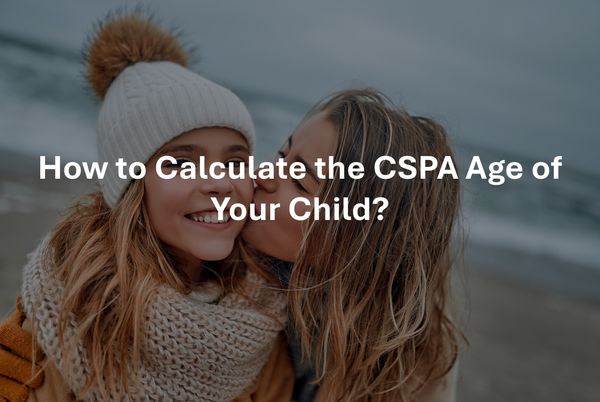The CSPA (Child Status Protection Act) age, or "CSPA age," is a rule used in the United States to calculate the "protected age" of dependent children in immigration processes in order to prevent them from becoming ineligible due to "aging out" (i.e., reaching the age of 21 during the processing of a visa application). The calculation of the CSPA age can help determine whether the child is still considered a minor, even after turning 21, for immigration purposes.
How to Calculate the CSPA Age:
How to calculate the CSPA age:
1. Determine the child's actual age at the time a visa became available for her:
· This date can be the approval date, if the visa bulletin of that month covers the priority date of the petition; or
· The first day of the month when a visa becomes available (the visa bulletin covers the petition’s priority)
2. Calculate the processing time of the petition:
· The next step is to calculate how long the petition took to be processed. This is done by counting the number of days between the filing of the form (the date the petition was received) and the approval of the petition (the approval date by USCIS).
3. Subtract the petition processing time from the child's age determined in step 1:
· The child's age (at the time the visa becomes available or when the underlying petition was approved) is then reduced by the processing time of the petition. That is, the amount of time USCIS took to approve the petition is subtracted from the child's age at the time the visa became available.
4. Additional requirement (Sought to Acquire Requirement): The child must apply for the visa within 1 year after the visa availability date, to qualify for the benefits of the CSPA. This means that the adjustment of status form (I-485), filing of Form I-864, submitting Form DS-260, or payment of the NVC (National Visa Center, if the process is consular) fee must be submitted within 1 year after the visa becomes available. However, if a visa initially becomes available and then becomes unavailable before the applicant “sought to acquire” requirement is met, the applicant’s CSPA age is not lock in and will continue to run until a visa becomes available again.
Example 1: Mary, John’s daughter (EB-2 NIW process)
Mary’s Birthday: December 11, 2001
Priority Date: August 19, 2022
Approval Date: March 18, 2023
The CSPA Age (which must be less than 21 years old for Mary to have the right to be dependent in the process) = “Age at time of visa availability” minus “Pending time of the application.”
The “Age at time of visa availability” coefficient must be the age at the time of approval (if the “priority date” of that month’s visa bulletin is “current”) or the age on the first day of the month in which the “priority date” (I-140 filing date) becomes “current”.
The coefficient “Pending time of the application” would be the approval date minus the “priority date”.
On John’s I-140 approval date (March 18, 2023), his "priority date" (I-140 filing date – August 19, 2022) was "current":
As you can see above, the March 2023 Visa Bulletin was current for those who applied on or before November 1, 2022, that is, it was “current” for John Doe’s I-140 filing date.
Therefore, Mary's CSPA Age = “Age on the Approval Date” (21 years, 3 months, and 5 days) minus "time application was pending” (6 months and 28 days). Therefore, Mary's CSPA age = 20 years, 8 months and 7 days (LESS THAN 21 YEARS OF AGE)
After calculating the CSPA age, if the calculation results in less than 21 years, she would have 1 year to satisfy the “sought-to-acquire” requirement, assuming that the visa is still available for the entire 1 year. This means that, after March 1, 2023 (when the visa became available for John), Mary had one year to apply for the adjustment of status form (I-485) or pay the NVC (National Visa Center, if the process is consular) fees or file either Form I-864 or DS-260.
Example 2: David, Peter’s Son (EB-2 NIW process)
David’s Birthday: April 26, 2002
Priority Date: April 1, 2023
Approval Date: April 26, 2024
CSPA Age (which must be under 21 years for David to qualify as a dependent in the process) = “Age at time of visa availability” minus “Pending time of the application.”
The “Age at time of visa availability” should be the age at the time of approval (if the “priority date” from that month’s visa bulletin is “current”) or the age on the first day of the month in which the “priority date” (filing date of the I-140) becomes “current”.
The “Pending time of the application” would be the approval date minus the “priority date” = 1 year and 25 days.
Therefore, the first thing we need to check is whether, on the approval date (April 26, 2024), your "priority date" (filing date of the I-140 – April 1, 2023) was “current” in that month's Visa Bulletin.
The April 2024 Visa Bulletin was current for those who applied up to January 15, 2023, meaning it was not “current” on the approval date of Peter’s I-140.
Peter’s priority date (April 1, 2023) only became current in the January 2025 Visa Bulletin.
Thus, the “Age at time of visa availability” for David is 22 years, 8 months, and 5 days on January 1, 2025, when Peter's priority date finally became current.
Therefore, David's CSPA age should be calculated by subtracting 1 year and 25 days (pending time of the application) from David's age when a visa became available for Peter (on January 1, 2025, David was 22 years, 8 months, and 5 days old).
This makes David's CSPA age 21 years, 7 months, and 10 days. Since the CSPA age is over 21 years, David is not eligible to be included as a dependent in the process.

